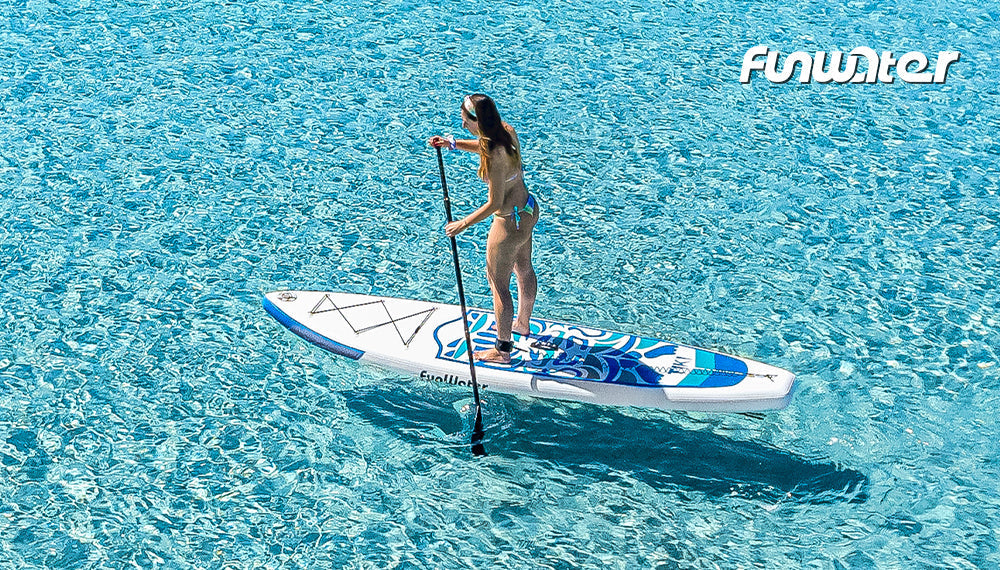
Advanced paddleboard Guide: How To Improve Your Rowing Efficiency
Want to go from paddleboarder to water master? This guide is for you! We'll delve into how to make boating more efficient so you can go faster, farther and with less effort on the water.
1. Posture Determines Efficiency
1.1 Stance: Feet shoulder-width apart, toes facing forward, knees slightly bent. Imagine yourself as a tree rooted in water, with a tight core and a straight back.
1.2 Oar grip: Hold the oar rod with both hands, with the upper hand at shoulder height and the lower hand in the middle of the oar rod. Keep your arms relaxed and don't shrug your shoulders.
1.3 Vision: Look ahead, don't look down at your feet. Keep your head and spine in line.

2. Paddling Skills:
2.1 Entry angle: Insert the blade into the water at a 45 degree Angle to ensure that the blade is completely submerged.
2.2 Stroke path: Draw long, straight lines along the edge of the paddle board, as if you were cutting a cake.
2.3 Core power: Use the core muscles to drive the body to rotate, rather than relying solely on arm strength.
2.4 Exit time: When the blade reaches the ankle position, pull the blade out of the water and prepare for the next stroke.
3. Productivity Tips:
3.1 Choose the right paddle: Choose the right paddle length and blade shape according to your height and rowing habits.
3.2 Use of wind: When the wind is downwind, you can use the wind to glide and save energy.
3.3 Keep the rhythm: Find the rhythm that suits you and maintain a steady pace.
3.4 Teamwork: When multiple paddlers are paddling, staying in sync can greatly improve efficiency.
4. Advanced Skills:
4.1 Steering skills: Learn to use skills such as sweeping and reverse paddling to control the direction more flexibly.
4.2 Wave handling: Mastering the skill of balancing in waves will allow you to navigate more complex waters.
4.3 Fancy tricks: Try some fancy moves, such as 360-degree spins and jumps, to increase the fun of paddling.
5. Safety Tips:
5.1 Wear a life jacket: Regardless of technology, always wear a life jacket.
5.2 Be aware of weather changes: Avoid paddling in inclement weather conditions.
5.3 Go with a partner: try to paddle together and look after each other.
5.4 Know the water conditions: Know the water conditions in advance to avoid dangerous areas.

6. Equipment Selection:
6.1 Paddle board type: Choose the right paddle board according to different waters and uses, such as leisure board, travel board, racing board, etc.
6.2 Choice of paddle: Choose a light, strong paddle, and adjust the length of the paddle according to height.
6.3 Other equipment: Consider using ankle ropes, waterproof bags, sunscreen clothes and other equipment to enhance safety and comfort.
7. Training Plan:
7.1 Set goals: Set clear training goals, such as increasing speed, increasing endurance, mastering new skills, etc.
7.2 Step by step: Start with the basic movements and gradually increase the difficulty and intensity.
7.3 Cross-training: Combine other sports, such as swimming, running, yoga, etc., to improve the overall physical fitness.
7.4 Record progress: Record training data, such as rowing distance, time, speed, etc., to track progress and maintain motivation.

8. Enjoy The Process:
8.1 Explore new waters: Try paddling in different waters, such as lakes, rivers, oceans, etc., to experience different landscapes and challenges.
8.2 Participate in activities: Participate in paddle boarding competitions, tour groups, training camps and other activities to meet like-minded friends.
8.3 Relax: Use paddling as a way to relax and enjoy water sports.
Remember, practice makes perfect! With practice, you can master these skills and become an efficient, confident paddleboarder. Enjoy the fun of water sports!
